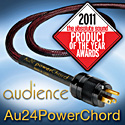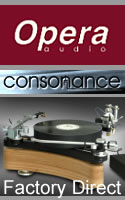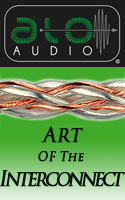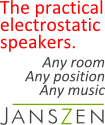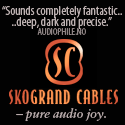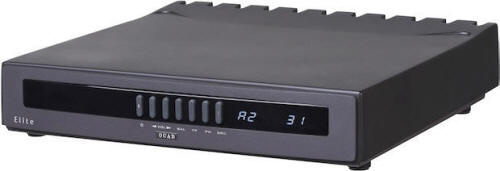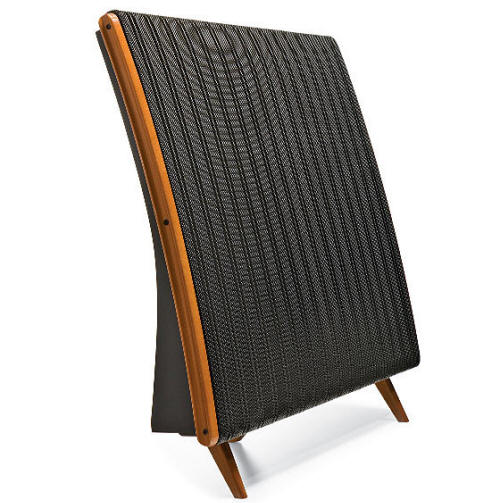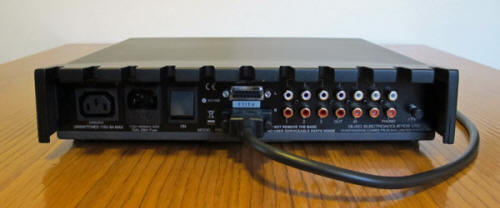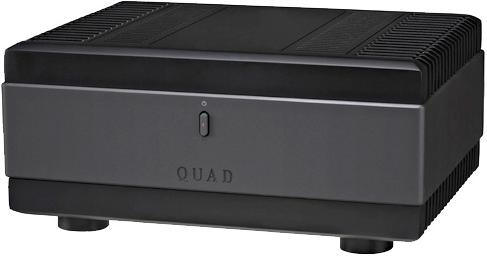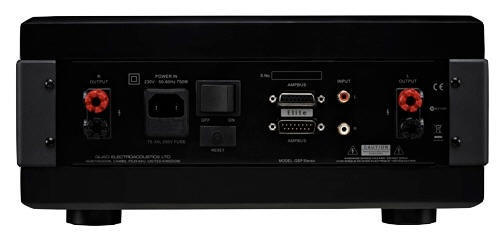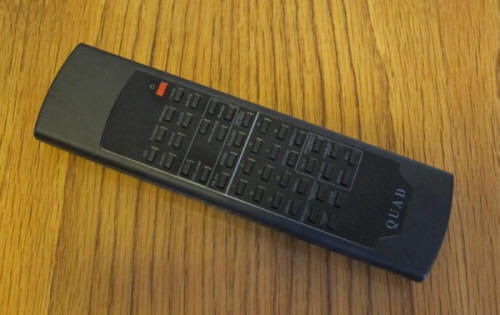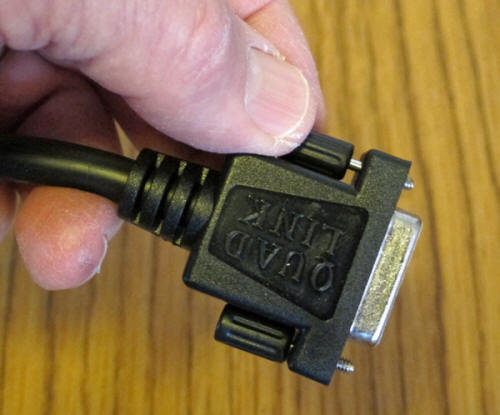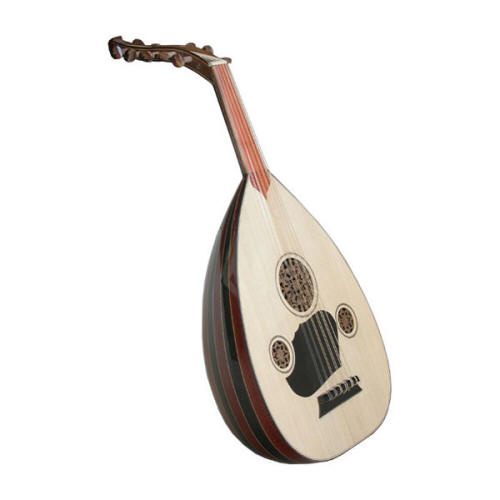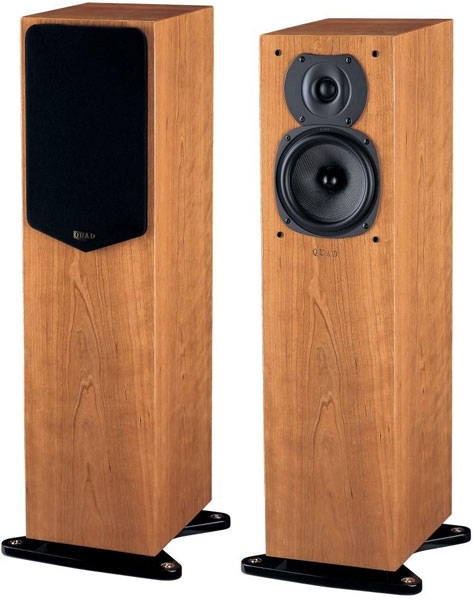|
|
You are reading the older HTML site
Positive Feedback ISSUE 59
quad Elite Preamplifier and QSP Stereo Amplifier as reviewed by Kent Johnson
Quad is one of the truly venerable companies in the audio business. Founded by Peter Walker in 1936, Quad made the first full-range electrostatic loudspeaker in 1957. Pictured above, this iconic speaker was known as the Quad Electrostatic Loudspeaker when new and the Quad Model 57 today. Interestingly, the Model 57 is probably more desirable and highly-regarded today than it was when new, as are a number of other Quad products.
Quad has always been known for high value, musically satisfying home audio equipment. Their well-known motto is "QUAD the closest approach to the original sound." Today, they are part of the International Audio Group (IAG Ltd.) and all Quad products are made in China. Their audio lineup includes electrostatic and conventional loudspeakers, tube and solid-state amplifiers, preamplifiers, and integrated amps, as well as tuners and CD players. Some of their recent tube equipment has been designed for Quad by Tim DeParavicini who is best known for his own line of E.A.R. audio equipment. One of IAG's manufacturing strengths is what is known as "vertical integration." This means that they make literally everything themselves. Nothing gets farmed out, not even the binding posts for the loudspeakers. This capability insures a high level of quality control and cost-effectiveness. I have owned a pair of Quad 21L2 loudspeakers for several years and think very highly of their sonic capabilities as well as their beautiful cabinetry. They are the only Quad components that I have heard however, so given the chance to hear one of their new preamplifiers and amplifiers, I seized the opportunity. So here we have an Elite Preamplifier ($1199) and QSP Stereo Power Amplifier ($1899) for review. Both are solid-state designs. Description The Quad Elite preamp is compact, measuring only 12.5" wide by 12" deep by 2.5" high. The top and sides are a single aluminum casting. The bottom plate is steel. For its size the Elite feels very dense, weighing in at about 10lbs. The castellated top plate cantilevers over the back panel by about an inch, which looks nice but makes getting to the rear panel connections more difficult than it would otherwise be.
Those connections are (going from left to right) an unswitched AC outlet, the IEC AC input, the mains on/off switch, the Quadlink input and output, three Auxiliary inputs, a Tape Loop, the right and left channel Preamp Outputs, and the Phono Inputs with ground terminal. All the connections, except for the Quadlink, are unbalanced RCAs. The Quadlink connection provides balanced signal connections as well as control capabilities that allow a single remote to run all Quadlink-connected equipment. The Quadlink cable has a 15 pin computer-type connector at each end. The front fascia of the Elite has seven push-buttons in the center with the display to the right side. These buttons include a Stand-By switch that glows red in stand-by mode and white when the Elite is powered on, up and down Volume Controls, Balance Control, Tape Monitor, Phono Input, and Source Input. The Source Input switches between the three rear panel auxiliary connections displaying them as A1, A2, and A3 as well as CD and Tuner, which are only available using the Quadlink connection. The Balance Control turns the balance mode on; the Volume buttons are then used to change the actual level. Likewise, holding in the Phono button for five seconds toggles the Phono section between Moving Magnet and Moving Coil settings. Access to the Tilt, Bass, or Filter settings is also possible via the front controls. You will need the manual to make some of these adjustments, at least the first time. The manual is exceptionally useful and well written. The Elite's display is a very legible white on black with larger than average characters. There is no dimmer or off setting for the display. The front fascia controls are duplicated on the remote control. In addition to changing between MM and MC phono sections, the remote provides access to three sensitivity settings for each section. The settings for Moving Magnet cartridges are 7.75mV, 3.00 mV, and 1.00mV. For Moving Coil, the listener has a choice between .775mV, .300mV, and .100mV. I did not find any information as to capacitance or resistance settings for either phono section in the owner's manual. Line level inputs can be adjusted so that different inputs play at the same volume level. The Elite Preamplifier comes with Quad's famous Tilt tone controls. Tilt Control offers three settings with Bass Lift and Treble Cut and three settings with Bass Cut and Treble Lift as well as a flat setting. The frequencies affected by the Tilt settings are below 300Hz and above 3000Hz and so the midrange is largely unaffected. Finally, there are the Bass and Filter Controls. The Bass level can be boosted about 3dB over a range of approximately 20-80Hz or cut to a maximum of about 4.5dB below 30Hz. The Bass can also be set to flat. The Filter Control is actually a treble cut and comes in gently above 7000Hz. I have simplified the Bass and Tilt information somewhat here; there is considerably more detail in the Owner's Manual. The Quad remote has 43 buttons and there are still quite a few of them I have not mentioned. Most of these control either the CDP or CDS CD players or the Elite FM Tuner. QSP Amplifier
I think the QSP Amplifier is visually very interesting. Unlike most amplifiers which are essentially a box, the QSP's form mirrors its internal construction, though there is a very unitary quality to its appearance. With its black powder coated paint, it looks like it should plug in somewhere on the Millenium Falcon. The QSP's front fascia features only a Stand-by switch that glows red when off and white when on.
On the QSP amplifier's rear panel, again going from left to right, are the Right Channel Speaker connections, the IEC AC input, the mains power on/off switch, the Quad Link connections, a single pair of RCA Line In jacks, and the Left Channel Speaker connections. The QSP features Quad's unique "Current Dumping" which utilizes a low power high quality amplifier that is in turn supported by a simpler high power amplifier when needed. Here is the explanation from the Quad's web site: "Current Dumping - The QSP Amplifier incorporates QUAD's patented current dumping technology developed by QUAD's founder Peter Walker, and is one of the finest audio amplifiers available. One of the few truly innovative amplifier topologies, it is essentially a combination of two amplifiers to give the best of both in each channel. The current dumping circuit like the Quad QSP Amplifier consists of a very high quality class A low-power amp which provides the details of the signal, while a high-power current dumping section provides the grip to keep the speakers under control. These two amplifier circuits are combined with a precision network to perfectly impose the finesse of the class A output onto the power of the current dumper." Where the QSP improves over its predecessors, such as the 909 amplifier, is in the use of audio-grade, tighter-tolerance components. More attention has also been given to screening the signal paths and shielding. Here is what the QSP manual has to say: "Quad engineers have carried out extensive research on screening options. Flow of magnetic fields and cross-talk were carefully highlighted. New PCB [Printed Circuit Board] layouts to screened signal paths and custom-made transformers, alongside shields protecting amplifier boards from mains interference are [a] few of the many innovations. The result is a very clean technical performance and a high dynamic range." Finally, the Quad web site provides the following information regarding the QSP's power rating: "With 140W per channel into an 8 ohm load, and plenty more into lower impedances ensures that there is ample power into a wide range of speakers, including the QUAD ESL range." Quad Remote
The Quad remote is plastic and has 43 buttons on it. One of these buttons is red to indicate the Power on/off control. The rest of the buttons are black and exactly the same size. The labels on the buttons are light gray on a dark gray background. These labels are only readable in good light and then you may need your reading glasses or a magnifier to make them out. Fortunately, the Volume Controls are slightly separated from the rest of the buttons and your right thumb quickly becomes accustomed to their location. From the Volume buttons it is then possible to access the Balance and Bass controls by feel with a fairly high degree of accuracy. Fortunately, the Elite Preamplifier's display provides a visual confirmation of any changes made from the remote. The Remote works great but why not at least two more red buttons for the Volume controls? Setting Things Up Having noted the labeling and buttons on the Remote control let me get the rest of my criticisms out of the way.
The Elite Preamplifier came with the Quadlink cable already attached to its output, so I left it there for the entire review. There was a reason for this. The thumbscrews used by Quad for fastening the Quadlink cable are impossible to get to grip. If you look at the photo, you will see that they are too close to the plug itself, too short, and too slippery for any normal sized fingers to grasp. Why couldn't the plastic portion of each screw be extended enough to clear the plug, making connecting and disconnecting a simple process instead of one of frustration? Unless the Quadlink is fastened tightly—and it won't stay in place just via sheer friction—there is hum through the system. When I needed to disconnect the Quadlink from the QSP amplifier, the only way I was able to do so was with long-nosed pliers. Thanks to the low profile, and the overhang of the top, space is very tight on the back of the Elite Preamplifier. Each pair of jacks is oriented vertically on the rear of the chassis and there is very little room in between. I found it necessary to attach the Left channel RCA (the upper one) first as once the lower Right channel RCA was in place, I could no longer get my fingers in around the Left channel plug to do anything with it. Once in place, the barrels of the cables I used had virtually no clearance between them. Granted, these cables use locking connectors, which added to the clearance problems, while cables that push on and off should be easier to deal with. Still, I was left with concerns as to whether I was actually making the best possible connections. The QSP amplifier offers its own idiosyncrasy in the form of its binding posts. Due to European Union regulations (as I understand it) the QSP's speaker connections are limited to 4mm plugs or bare wire. That's it. I cannot image someone buying a $1900 amplifier and using bare wire. I have to wonder how many audiophiles would pass on the QSP simply because they already own speaker wires terminated with spades. So what I don't understand is why a different binding post could not be installed at the factory for the American market and those not subject to EU regulations? Fortunately, I use 4mm plugs so the connectors were a non-issue in actual use. Perhaps I am being overly picky here but I am bothered by the thought that listeners will end up using sonically inferior cables with the Quad equipment simply because they are easier to connect. That would be a real pity. Listening I began listening to the Elite Preamp and QSP Amplifier using the Quadlink connection. They replaced my McIntosh MA6300 integrated, which has been my reference amplifier for nearly a year. Serving as the source was a McIntosh MVP-871 universal player with Magneplanar MG1.7s speakers. The interconnect cable between the 871 and the Elite was Zentara Reference while the speaker cables were Zentara Reference 2. The Quad components were already broken-in and I heard no change in their sound during the time I had them here for review. Initial impressions were very positive. Beginning with This is Jazz 8, Miles Davis/Acoustic (Columbia CK64616) the Quad components presented a wide deep soundstage with plenty of spaciousness and a very good sense of the recording's acoustic space. Piano sounded very good over its frequency range and Mile's trumpet had a realistic edge to its sound. This is a compilation CD and it was easy to hear the changes in sound due to the different venues and time frames from which the tracks had been drawn. The sound was quite good overall but some of the tracks were clearly better recorded than others. Tierney Sutton's Something Cool CD on Telarc (CD-83548) has proven to be a useful reference for hearing subtle variations between components, as well as a recording that remains enjoyable despite repeated listening. As always, her voice was lovely and the supporting instruments were reproduced with excellent fidelity. It was also immediately clear that the acoustic bass on this recording was deeper and had better dynamics than had been the case through the McIntosh MA6300. With the MG1.7 speakers this particular improvement was immediately obvious. This upgrade was free from boom and came with the sort of definition that could provide a novice bass player with a private tutorial. Whatever the power output of the QSP amplifier is into 4 Ohms, it is definitely sufficient. Track 8, "Alone Together" is a demonstration-quality cut featureing Tierney's voice with only solo acoustic bass accompaniment. Here the mids and highs of her voice meshed beautifully with the lower foundation provided by the bass. It is simply terrific. The QSP may be somewhat self-effacing cosmetically but it certainly lets its low-end performance do the talking. All was very good, but, alas, not perfect. Continued listening revealed a discernible lack of extension of the high frequencies accompanying Tierney's voice. This lack of extension also affected the cymbals, noticeable as possessing less shimmer, as well as the higher harmonics of woodwinds, strings, and the piano. Listening to Holly Cole's Shade (Alert 6152810392) reinforced these good (bass) and less good (high treble) qualities that I had been hearing. David Piltch's bass had wonderful weight and body which made it sound truly in-the-room real, but Holly's voice had the same subtle deficiency of air and, in some cases, an almost blunt quality that I had also heard, though to a lesser extent, from Tierney Sutton. At this point, I replaced the Quadlink cable with a second length of Zentara Reference. It should not come as a shock that a $1000 top-of-the-line interconnect improved on the performance of one that came packaged free with the QSP Amplifier. Changing this cable removed the control capabilities of the Quadlink connection. Fortunately, the only change it made in my set-up was no longer turning the QSP amp on and off remotely. The air I was used to hearing through the McIntosh amp was back. The upper harmonic extension now mirrored that of the lower harmonics, providing an excellent sense of musical balance and of a system truly working full-range. For many listeners who might come to the Quad components from a receiver or integrated amp, I expect that the Quadlink cable will improve on what they have heard or, at worst, be as good as they have heard. As free connectors go, it is the top of the pile. There is still more to hear, however, through these Quad components. While I don't regard the Zentara interconnects as overkill from a reviewing standpoint—my job is to listen for and describe the typically subtle differences that I hear between components—they are fairly expensive relative to the Quad components. The Niangua cables, which I reviewed in PFO Issue 58, would also be an excellent upgrade from the Quadlink while perhaps being a bit more suitable economically. While listening to these and other CDs, I tried out the Elite Preamp's Bass Control—primarily the boost capability. This additional bass comes in right where the MG1.7's output is falling off. Overall, it worked very well. The additional bass reinforcement is well defined and comes almost totally free of boom and is subtle enough not to make its presence obvious. I found it very useful especially on some older jazz and classical recordings where it integrated into the performance without drawing any attention to itself. The most interesting thing about it though, was how totally unnecessary it was 98% of the time. I found the bass performance of the Quad combo excellent through the MG1.7s on virtually every CD I listened to and felt absolutely no desire to reinforce or supplement it at all. Certain things surprise you in any review and that has been the one for me in this one. If you think Magneplanars lack bass impact or definition, you haven't heard them with the QSP amplifier. If you are a Maggie owner looking for an amp, you should make every effort to audition the QSP with your speakers. I mentioned earlier that I heard no change in these components that I could ascribe to break-in during the time I had them. This is true. What is more interesting is how though, they seemed to get better sounding the longer they were being listened to. They sounded very good after twenty minutes of warm-up (the bare minimum they need), better still after two hours, and, I swear, better yet after four hours or so. I attribute this situation primarily to the QSP Amplifier which does run very warm. Not scary hot where you would have to be concerned about small children or pets hurting themselves or setting fires, but warm enough to notice that it is generating some serious thermal output. This heat emanates from the entire body of the amp. Every part of the chassis seems to work as a heat sink confirming my opinion as to its unitary construction. While this heat benefits the sound quality, the QSP is probably not an amplifier that you would want to leave on all the time. I think the Elite Preamplifier would benefit from being on continually but this will only work if the Quadlink connection is not in use. The Quad components and MG1.7 speakers provided audiophile quality sound with excellent sound staging, deep bass, lovely midrange, and extended treble. Extensive listening left me feeling that the Quad pair, overall, got everything very right. If there were any additions or subtractions to the sound, they were sufficiently minor as to not be obvious on their own. It was at this point, that I exchanged the Elite Preamplifier for my Dodd Midline tube unit. The Dodd was upgraded with Psvane (Pavane) 12AX7 tubes a while back, which kicked its performance level up several notches. Unlike the fully-featured Elite, the Dodd is non-featured being only a line stage with three line-level RCA inputs. I am not sure exactly what the Dodd sold for new, but I know it was considerably more expensive than the Elite Preamplifier. There was only one difference effected by the Dodd: low-level detail was noticeably improved. This could be heard in everything from barely audible mouth sounds, to better tonal colors, to an improvement in the already excellent sound staging. The Astounding Eyes of Rita, an ECM recording by Anouar Brahem (ECM 2075 B0013356-02) proved to be the perfect vehicle for hearing these differences. This recording features an oud, played by Brahem, bass clarinet, drums (darbouka and bendir), and acoustic bass. As with all ECM recordings, the sound quality is superb. The instruments play against a completely silent background so every nuance is readily detectable.
Until you hear the combination of oud and bass clarinet, you cannot imagine how lovely they can play together. There is richness to the bass clarinet in this recording that is not dependent upon euphonic warmth. It is complete within its "clarinetness." Its inherent woody resonances and low registers make it the woodwind correspondent of the cello. The oud sounded mellower and less resonant than a guitar. I imagine that it sounds very much like a lute though I don't have any equally well-recorded lute music from which to make a useful comparison. The drums sound very middle-eastern. The juxtaposition of these sounds—some familiar, some unusual—results in a sonic creation that simply sounds right even though you have never heard anything quite like it before. The improved low-level detail provided by the Dodd allowed me to hear not only small mouth noises from the clarinet player but how he also inflected the notes with small changes in air pressure as he played them. Air emanating from the instrument which had not been audible before could now be heard. The decay from the oud's strings was more evident and when these two instruments were joined by the drums; the whole soundstage was loaded with both the immediate notes being played as well as an extensive quantity of decaying resonances still reverberating from the notes previously played. It was gorgeous and for a sound staging freak, all that you could ask for. The sound stage also improved slightly. The Elite Preamplifier had laid out the geography of the sound stage with GPS-toleranced accuracy but now the Dodd filled in the fine details. It was easy to hear how neither the bass clarinetist nor the oud player was sitting absolutely still while playing but were moving slightly relative to the microphone. What is important to note here is not that the more expensive Dodd provided better low-level detail than the Elite preamp but how readily the QSP amplifier made those differences apparent. While the Dodd evinced some small limitations of the Elite preamplifier, it did not reveal the limitations of the QSP amplifier. The Quad 21L2 Speakers
The presence of the Elite and QSP in my listening room provided an opportunity to hear my 21L2 speakers with their Quad siblings. My source for this setup was a Sony XA-5400ES SACD player. Interconnect cables were DHLabs Revelations; the speaker cable was from Monster. I listened first to a compilation CD put out by Jaguar automobiles featuring some well-known vintage British rock bands and singers. Among the songs featured are the Hollies' "Long Cool Woman (in a Black Dress)," Van Morrison's "Brown Eyed Girl," David Essex' "Rock On," and a live rendition of "Lola" by the Kinks. I found the Quad trio's ability to make these songs not only come to life, but to absolutely rock, outstanding. As with the Magneplanars, the QSP found bass capabilities within the 21L2s that I had not realized were there prior. Music had detail, speed, and dynamics. Voices and instruments materialized and receded throughout the 21L2's expansive sound stage; this was especially impressive while listening to "Rock On". The huge stadium where the Kinks play "Lola" is given shape and there is excellent vocal intelligibility for what is a live performance. I am sure that the Dodd could have rendered somewhat more detail from these recordings, but I don't think the synergy of the Quad components could have been remotely equaled. It was tremendous fun to hear these songs so marvelously reproduced. Also fun was the new Muppet movie soundtrack The Muppets, (Disney D000650992). I was disappointed by the movie's unevenness but the soundtrack is wonderful. "Life's a Happy Song" and "Man or Muppet" sounded absolutely terrific—and left you singing long after the stereo has been turned off. The faux pretentiousness of "Man or Muppet" sends up about half the songs written during the 1980s. All of the songs on this soundtrack played to the strengths of the Quad system. The 21L2s can produce impressively deep and dynamic bass for their relatively small size and they disappear as well as any mini-monitor leaving only the music as proof of their existence. The sound is big and generally upfront. There is realism to the vocals and clarity to the highs. In a medium-sized room, this system is really all that anyone would need. What might be nit-picked regarding absolute audiophile-perfect reproduction is more than made up for by how these components animate the music. I have heard substantially more expensive systems that came nowhere near illuminating the heart of the music as effectively, something the Quad setup did stunningly. Continuing with the Quad system, I listened to an SACD that I have had for a while. It is Mozart's "Don Giovanni" arranged for wind ensemble (MDG 903 1464-6). The performers are Opera Senza, a group of nine instrumentalists. The instruments played include two oboes, two clarinets, two (French) horns, two bassoons, and a double bass. As an aside, I wonder why a double bass was used in this ensemble when the bass clarinet (which seemed to be everywhere I listened during this review) would appear to be a more appropriate choice. Here is a possible explanation: "Harmoniemusik," music for wind band, was extremely popular in the last decades of the eighteenth century. It appears that "Don Giovanni" was arranged for "Harmonie" ensemble within a year or so of its initial performance in Prague in 1787. The arranger was Josef Triebensee and it is thought that he worked directly from the opera version when the opera was presented in Vienna in 1788. The opera itself had proven something of a dud in the Austrian city at a time when there was a very high demand for "Harmoniemusik." Mozart saw having Triebensee do an arrangement of the music as an opportunity to improve his opera's profitability. (Paraphrased from the liner notes.) According to Wikipedia, the first instrument that could reasonably be called a Bass Clarinet did not appear until around 1793 and was not commonly in use until a decade or so later. Presumably, Triebensee could not have counted on having bass clarinets and experienced players readily available at the time he did the arrangement as he undoubtedly could have with the double bass. Having satisfied my curiosity, the point I wanted to make was that the sound of this recording is unpleasantly bright. This situation provided the perfect opportunity to try out the Elite preamplifier's Tilt controls and its Treble Filter setting. In order to get to the Tilt and Filter settings, the EQ (Equalization) must be turned on via the remote control. Once the EQ button is pressed, the Tilt button can itself be engaged. This toggles through six settings labeled +1 (for 1dB of bass boost with 1dB of treble cut), to +2, (2dB of boost/cut), to +3. Setting -1 offers 1dB of bass cut with 1dB of treble boost. Settings -2 and -3 follow the same pattern. I hope this is clear. Essentially each plus or minus setting, for example +3 and -3, is the opposite of the other in terms of what they boost and cut. Let's suppose you find that you like listening to CDs through the Elite with all the controls flat but prefer to use the -2 Tilt setting for vinyl. You can go ahead and set the Tilt to -2 since it requires the EQ to be turned on to be in the signal path. Turn EQ on for vinyl and then simply turn it off for CD since doing so completely bypasses the tone settings. Sweet really. I toggled my way through the Tilt settings looking for one that would mitigate the hot treble on the Don Giovanni SACD. The closest I came to something helpful was the +2 setting. This took a little of the edge off of the treble and gave the bassoons some additional weight. Even so, it was on the verge of inflating the bass to where it was threatening some boom however, and the treble cut really wasn't enough to solve the overall edginess of the disc. I tried the Tilt control with other discs as well and found that the +1 and -1 settings were really negligible in their effect and that the +3 and -3 settings both were unacceptably invasive, especially the -3 setting. In fact, I did not feel that any of the minus settings had any real benefits. I returned the Tilt control to flat and tried the Filter setting. This setting comes in at about an octave higher than the Tilt settings and only affects the treble. Even knowing when it was on or off, I could not hear any effect from it at all. I had hopes that this might be Don Giovanni's magic bullet but it was not to be the case. I had to conclude that the edginess of this SACD is simply beyond the capabilities of even the best type of tone control. Listening to these controls, confirmed my opinion that, when dealing with components as inherently well balanced as the Quad pair, tone controls seem disruptive, however good they may be. Listening to the Phono Section I do not have a vinyl setup so I asked my friend Steve if I could bring the Elite over to his house and try it in his system. He has a VPI HW19 MKIV turntable, an English Audiomods Series 4 Rega 250 tone arm, and Grado Reference Sonata cartridge as his front end. His preamplifier is a VTL 5.5. Steve also has Magneplanar speakers so the sound of his system is very congruent with my own, making for an easy and quick adaptation. We listened, along with another friend, to several records using the VTL preamplifier concluding with Sinatra's Only the Lonely from Mobile Fidelity. We then installed the Quad Elite and set the phono section to its moving magnet 3.00 millivolt setting. The Grado has a rated output of 2.5 millivolts. This seemed to work perfectly. The Elite had been sitting unplugged for several days before I took it to Steve's and had also been out in the cold during the trip over. Despite, this, I was hard pressed to hear any describable difference in the sound with it in Steve's system. Nothing was missing, nothing sounded at all off. Sinatra's baritone filled the sound stage with the same kind of presence it had with the VTL. The sound stage was just as large. After about half an hour of use, the sound through the Elite opened up further. Steve noted while listening to the Romeros play guitar, that he could easily locate all four guitars in the sound stage. The guitars sounded very fast with excellent treble extension and impressive clarity. Several tracks from Steely Dan's Gaucho also revealed excellent bass depth and timing. These comparisons between the VTL and the Elite were not by any means exhaustive but in the limited time available, the Elite more than held its own sonically. Overall, I think it is fair to say that the Elite impressed everyone. The phono section is definitely very good and has sufficient flexibility to allow the use of a wide range of cartridges. Summary This review has been somewhat longer than usual but these Quad components have a lot of interesting features as well as excellent sound qualities to discuss. Here is how the listening I have done sums up. The Quad Elite preamplifier and QSP amplifier connected via the Quadlink cable is a very good sounding combination. Only a lack of high frequency extension prevents the sound from being excellent. The Quadlink does provide a lot of convenience but, for me, the convenience is not worth the sonic tradeoff. The Elite and QSP connected via good quality interconnects was a wonderfully musical and satisfying combination. Its bass performance clearly improved over that of my reference McIntosh MA6300. Comparison of the Elite preamp to my Dodd line stage indicated that there is some low-level detail being lost by the Elite but it is only evident through direct comparison. The degree to which this loss is apparent will depend on the other components in use (source, speakers, and cables), the room, and one's hearing. Someone simply listening to the Quad components will not notice anything but how complete, lively, and realistic the musical presentation is. The phono section offers a lot of flexibility and seems to be, at the least, very good and possibly excellent. It deserves more listening time than I could give it. The Elite Preamplifier has an extremely quiet and neutral line stage, an incredibly versatile phono section, Tilt, Bass, and Treble controls, and other features as well. The usefulness of some of its features will matter more to some listeners than others but they come at no penalty in terms of sound quality. When the Elite Preamplifier's overall performance and numerous features are weighed against its $1199 asking price, the Elite preamp is a terrific buy, an absolute sonic steal. The QSP amplifier is even better. Its performance is remarkable—it offers bass power, midrange beauty, treble sweetness, and low-level detail. It can make performers sound stunningly real. It has all the audiophile attributes you could desire while never allowing them to overshadow the music itself. I feel fortunate to have had the chance to hear it play music. When all the features and specifications have been evaluated and absorbed, what remains is simply this: these Quad components are so musically satisfying that all you will want to do is listen to them. You'll listen. You'll smile. You'll be very happy. Kent Johnson
Quad Elite Preamplifier
Quad QSP Power Amplifier
Quad
|
